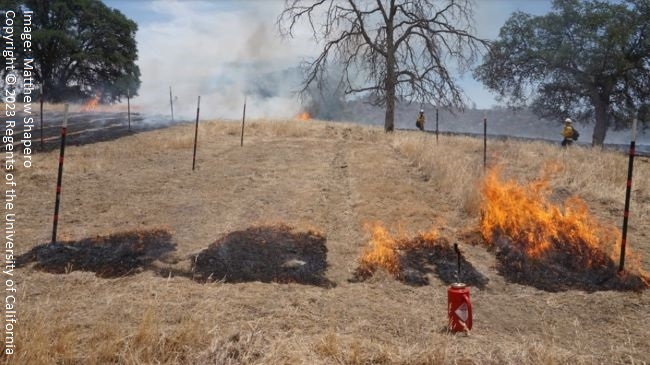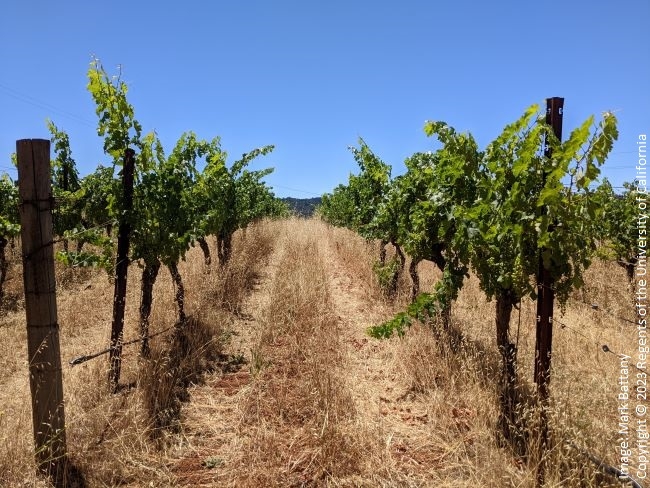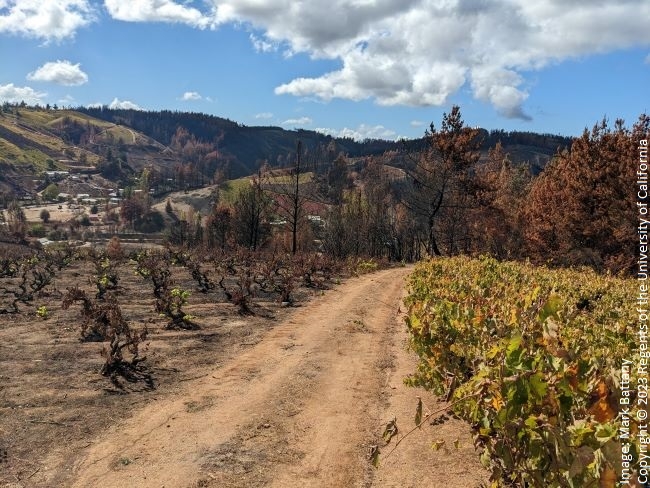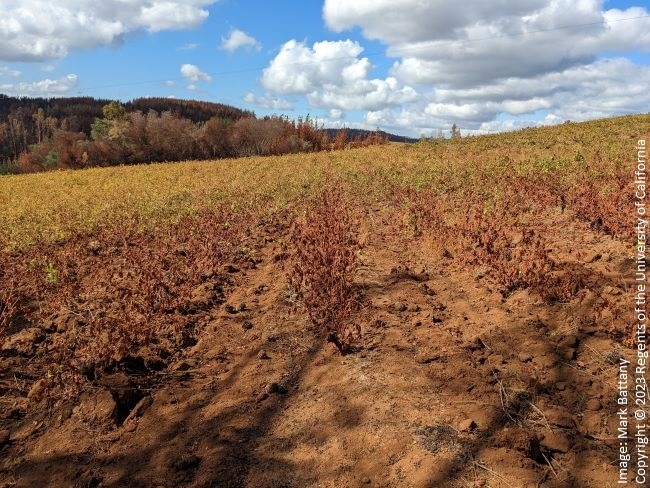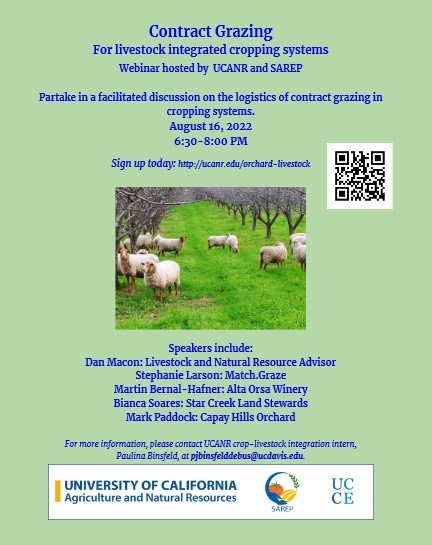
Posts Tagged: cover
Fire and Dried Cover Crops
Vineyards and orchards have long used winter cover crops to help reduce erosion, improve soil structure and prevent nutrient leaching. Growers are being encouraged to increase their use of cover crops to help capture atmospheric carbon dioxide and fix it as soil organic matter, thus helping mitigate climate change.
However the dry residues resulting from abundant cover crop growth can also serve as a highly flammable fuel if fire occurs at the vineyard or orchard. The risk of fire occurring in any given year is likely small, but many coastal areas of California are rated as having a very high or high fire hazard (see the Fire Hazard Severity Zones Maps).
The picture below offers a clear visual example of just how flammable these dry plant residues can be. This is from an experiment by Livestock and Range Advisor Matthew Shapero and colleagues of how different grazing levels affect fuel quantities and therefore fire behavior. The plots with low fuel levels burn at lower fire temperatures and with lower flame lengths while the higher fuel levels result in much more intense fire behavior.
The California vineyard pictured below in July 2022 is an example of how the management decisions with cover crop residues can result in a very elevated fire risk. This cover crop of oats has full surface coverage and the abundant residues have mostly been left standing. The vines themselves and especially the drip irrigation lines are at very high risk of burning if fire was to ever occur under these conditions. The lack of bare ground under the vine rows will also allow fire to move across the rows and potentially impact the entire vineyard from a single ignition point.
The picture below is from an area in Chile which suffered extensive forest fires in early 2023. In this region, vineyards which had large amounts of dried cover crop residues suffered far more damage than vineyards without such residues. The vineyard on the left had a large amount of dried residues from a lupine cover crop and as a consequence burned very intensely, while the vineyard on the right had very little dried residues and had virtually no direct fire damage to the vines.
Another example from the same region is the effect that the burning of adjacent trees had on a vineyard with little dried residues. In the picture below tall burned pine trees were directly behind the photographer (you can see the shadows of the trunks) but only the near edge of the vineyard was damaged by radiant heat from the burning trees. Undoubtedly many burning embers landed within the vineyard as the trees burned, but the lack of dried residues resulted in no fires within the vineyard.
The take home message from this short article is that dried cover crop residues are highly flammable! With the abundant rainfall in California this past winter we are seeing heavy growth in cover crops this spring which will lead to heavy levels of dried residues this summer. For vineyards and orchards in higher fire risk areas these residues should be managed to help minimize the risk of catastrophic damage if a fire was to occur there.
With all this rain, the trees and the cover crops are thriving, but with an annual cover crop that dries out when the soil moisture dries up, it could be a fire hazard. It should be mowed prior to fire season.
Thanks, Mark Battany, for the reminder - https://ucanr.edu/blogs/blogcore/postdetail.cfm?postnum=56817
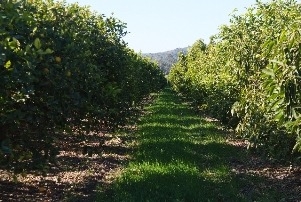
citrus cover crop
Sheep Grazing in Vineyards and Fields

Vineyard grazing flyer (002)
Cowpeas Can Make Money in Spanish Mandarins
If you can sell your cowpeas, fava beans and barley, you can make money in Spain and apparently not use any more water than if just growing the mandarins. And coastal growers should look at the fresh market. Have you ever tasted a fresh green cowpea or fava bean? Pretty darn good and consumers think so, as well.
A Diverfarming project study compares the environmental footprint and the economic performance of traditional mandarin monocropping as opposed to growing mandarin intercropped with herbaceous crops and the use of deficit irrigation
The transformation towards intensive agriculture has led to agricultural practices in Europe that have centred on increasing the yield and reducing costs in recent decades, and which involve a major dependence on external sources of agrochemicals and energy. These intensive monocropping systems have generated biodiversity losses, water contamination, and high rates of greenhouse gas emissions, as well as degrading the soil and reducing the ecosystem services.
Faced with this situation, the European Diverfarming project has trialled the diversification of crops throughout the European Union, seeking the best practices to combine crops and focusing on reducing inputs to find the best options to preserve the sustainability of the systems and increase the resilience of the European agricultural sector. To do so, it is also necessary to know the impacts of these practices both at environmental as well as economic level.
With the aim of knowing the environmental footprint and the economic performance of the introduction of herbaceous crops among the alleys of the mandarin trees using controlled deficit irrigation in a mandarin grove located in the Region of Murcia, a team of researchers from the Universidad Politécnica de Cartagena have carried out a life-cycle assessment of the crop and an evaluation of the costs and income of the farm for the three years that the experiment in this case study was carried out.
Although the growing area increased with the introduction of the herbaceous crops (in this case purslane, cowpea, broad beans, and a barley-vetch mix), no detrimental effects occurred in terms of exhausting resources, acidification, or global warming. Therefore, the practice of intercropping did not cause additional contamination or other environmental impacts. This, in addition to the results of the increase in nitrogen and organic carbon content and in the soil and the reduction in erosion and run-off makes the introduction of herbaceous crops in the alleys of the mandarin trees a good sustainable environmental option to cope with the current challenges of the sector.
In economic terms, the financial security of the agricultural community also becomes a key element for successfully adopting diversified systems. This study highlights, through the economic assessment, that intercropping can lead to an increase in production costs, mostly related with a greater demand for labour in comparison with monocropping. However, the study also concludes that “the correct choice of intercropping practices can bring economic advantages”. The results showed that the mandarin crop with purslane and broad beans as intercrops could be profitable and reduce the risk for the grower against volatile prices in the main crop.
In this way, considering all the potential environmental and economic benefits of intercropping practices, these systems arise as a tool to move towards more sustainable and profitable agricultural systems. The valorisation of agricultural products that are more respectful to the environment on the part of consumers and the backing of public funding (e.g., direct help to growers who introduce intercropping) are key aspects to drive the adoption of these practices.

pixie harvest 2
Cover Crops and Healthy Soils
Lockeford Plant Materials Center
Cover Crop and Soil Health Field Day
April 6, 2022 - 10 -12pm
Agenda
Fava Bean Advantages in Cover Crop Mixes – Hossein Zackeri, Chico State
Cover Crop performance for the Central Valley - Tom Johnson, Kamprath Seed
Conservation Cover Study – Perennial planting for orchards and vineyards – Margaret Smither-Kopperl, NRCS
Field Border Study in the Healthy Soils Program – Anthony Fulford, UCANR
Changes to Soil Health at the PMC - Demonstration - Z. Kabir, NRCS
Location: Lockeford PMC, 21001 N. Elliott Rd., Lockeford, CA 95237
Please Register for the event here: https://surveys.ucanr.edu/survey.cfm?surveynumber=36926

cover croppwed citrus
Using Native Plants as Cover Crops
In late February, in an almond orchard in the Sacramento Valley, the fall-planted cover crop mix of grasses, brassicas and legumes had barely produced a green fuzz above the soil surface, and it was unclear when it would bloom.
Unfortunately, this scene is becoming more frequent across California, as climate change causes more prolonged droughts and rain-dependent winter cover crops can barely grow, which delays or reduces bloom, essential for supporting pollinators.
Fortunately, California native plant species have evolved with drought and have developed many strategies to survive and reproduce in those conditions.
Would it be possible to capitalize on the over 9 million acres of cropland in California for drought resilience and habitat restoration by utilizing more native species as cover crops? Our team at the UC Sustainable Agriculture Research and Education Program (UC SAREP) spent some time considering various native plant species and their potential ecological and operational attributes as cover crops. For a full list of species and their attributes, see https://ucanr.edu/sites/covercrops/.
Many native species are so well adapted to drought that they will still germinate and bloom during extremely dry years, for example, annuals like Tidy Tips (Layia platyglossa) and California poppy (Eschscholzia californica). Alternatively, perennial bulb species like Prettyface (Triteleia ixioides) and Bluedicks (Dipteronstemon capitatus) become dormant during the dry summer, retaining their bulbs below ground and re-growing when the rains return.
ADVERTISING
These species could perhaps fit well in no-till orchard systems. Summer dormancy is important for tree nut growers because they usually need clean ground under the trees during harvest. Moreover, the costs to terminate and reseed would potentially be eliminated. While these species are well-known by Native Americans for their edible bulbs, at this point in time, we are not aware of any cover cropping trials having ever been conducted with these species.
A harvestable product
Cover crops are not usually considered marketable crops. However, we should not preclude the potential for some plants that are useful as cover crops to provide a harvestable product as well.
Native perennial fiber plants such as Indian hemp dogbane (Apocynum cannabinum), narrow leaf milkweed (Asclepsias fascicularis), and common nettle (Urtica dioica) could offer the opportunity to cultivate summer cover crops that have a market value, especially in cases where farmers are already willing to irrigate their cover crops to improve their development and amplify the benefits.
Bowles Farming in the San Joaquin Valley is experimenting with growing these three species for fiber production. All three also attract native bees and important butterfly species such as monarchs (as long as farmers avoid spraying insecticides).
While we believe that some native species could open new opportunities for farmers as cover crops, we still have insufficient studies testing the effects and viability of these species.
Organizations like the NRCS Plant Materials Center at Lockeford and the Xerces Society are conducting practical studies with native species, creating plant guides and working with farmers to expand their use. In addition, researchers Lauren Hale of the USDA Agricultural Research Service and Anil Shrestha of California State University, Fresno, are using a 2021 UC SAREP small grant to study the effects of native species mixes on water demand and weed populations in San Joaquin Valley grape vineyards.
Hale suggests that below-ground ecosystems may benefit as much from native plants as above-ground ecosystems. Says Hale, “Because plants and their microbiomes have evolved together for millennia, it seems logical that native plants would promote a good response from the native soil microbiota.”
For additional information:
UC SAREP List of California Native Species for Potential Use as Cover Crops: https://ucanr.edu/sites/covercrops/
Xerces Society lists of pollinator-friendly native species for California: https://xerces.org/pollinator-resource-center/california
NRCS California Plant Materials Center plant guides: https://www.nrcs.usda.gov/wps/portal/nrcs/publications/plantmaterials/pmc/west/capmc/pub/
UC SAREP Cover Crops Database: https://sarep.ucdavis.edu/covercrop

cover crop citrus

